Stats On Natural Versus Cesarean Births Are A Barometer For A Breed’s Reproductive Health

I breed Norwich Terriers. It is what I call a “Cesarean” breed. Many breeders deliver their puppies through scheduled c-sections, meaning that they never give their bitches a chance for free whelping, because through their own experience, or horror stories of others, they choose a path that in their mind ensures the safest delivery. This approach may work for individual litters but the damage inflicted on a breed as a whole is devastatingly deleterious.
First, the art of assisting in a natural birth is lost, with all its implications for future generations of breeders and their charges. And second, breeders never find out which of their bitches indeed have any difficulties delivering puppies and which would have delivered perfectly easily if given a chance, and thus compounding any whelping problems in consecutive dog generations. How can you improve reproductive health and birthing when the data is never accumulated and so the problem cannot be addressed by judicious selection of mating pairs?
During my many years as a health chair for the national breed club I had a chance to talk to people involved in a fabulous diversity of dog breeds, geneticists and theriogenologists (reproductive specialists). There is a pattern of reproductive concerns, where breeds with high incidence of c-sections tend to also have higher risk for resorbed pregnancies, stillborn births, premature births, difficulty conceiving and extremely small litter sizes. I believe that one of the factors is an abdication of breeders’ responsibility to keep the breed’s health at the forefront of every decision. When we focus too narrowly on what might be easiest for us at the moment and forget our responsibility to the breed as a whole, decisions to have scheduled c-sections result. Those individual decisions, much too often made more out of fear than educated risk analysis, cumulatively hurt a breed.
In my opinion accepting inability to free whelp a litter as a breed’s trait and not even attempt to improve it through selective breeding is a very unfortunate mind set. I recognize that some brachycephalic breeds are too far gone in that direction (because of fetal size to pelvic opening disparity), and even the most ethically introspective breeders have little chance of making a meaningful shift towards free whelping. However, I see Norwich terriers heading in that same precipitous direction for avoidable reasons and I know it is not too late to change this dangerous course. I also know Norwich are not alone on that path, and other breeds experience similar shift towards compounding reproductive problems by more and more breeders opting for scheduled c-sections.
Don’t get me wrong. I am not advocating throwing the baby out with a bath water. You have every right to choose breeding your otherwise virtuous female who cannot deliver puppies naturally. And if you do, she needs an elective c-section. But please truly learn to distinguish between problems that require medical assistance and those easily addressed with proper birthing assistance. Often just understanding the process correctly solves the imagined problem. If the bitch is indeed unable to give birth, consider her inability to free whelp as a trait to improve on and choose a stud accordingly, the one who was born through a natural birth, ideally with most of his family and cousins born that way.
And finally, let us not put perfectly capable bitches through unnecessary surgery that carries its own set of risks and considerable post-op discomfort.
How To Maximize The Chances of A Natural and Smooth Whelping?
Assisting in whelping is an art that combines knowledge of the process, intuition and a set of skills to address common challenges. Showing up and “winging it” only works when no assistance is needed and the dog would have had puppies with or without the breeder in the room. Education is key and nowadays breeders have many courses and workshops available to them, but assisting a few times in a natural birth before attempting going solo or having a mentor with you in the room is invaluable.
I decided to write this blog post to encourage a goal of a natural birth. It is not meant as a substitute for hands-on mentoring, nor to cover every aspect of a canine birth. You should start with seeking out a mentor and witnessing natural whelps. I free whelped 21 puppies of my own, after assisting in the births of 12 puppies whelped by other breeders (breeds other than Norwich). Twenty one puppies might not seem like a lot but it is all litters I have had ever since I decided to attempt free whelping in spite of fearful advice against it from other Norwich breeders. I had plenty of Cesarean whelps prior to investigating why Norfolk terriers whelped more easily than their close cousins Norwich. I found that a breeder culture was partly responsible, and I wanted to make a meaningful change. I am sharing what works for me.
Last Week of Pregnancy
Prepare. Prepare. Prepare.
This is true for the breeder and it is true for the bitch. A mama dog will have her nesting instinct kicked into a high gear. She will look for safe places to whelp her pups. Do not under-appreciate this important part of the process. I take this time as a chance to communicate to my dog my understanding of her emotional needs. I am not going to agree to prepare a nest behind a sofa, or in the bushes but I will keep offering spending quiet time together in a future whelping room. Sometimes, as in this case I am going to use as an illustration, I listen to my girl’s comfort and adjust. I would prefer to whelp a litter in my tiled basement all set up as a dog room but Kiwi made a point of constantly getting away from the basement level and seeking comfort upstairs in our house. Luckily I had a chance to use my adult daughter’s room, as she recently moved out to her own place. Once I allowed Kiwi to hang in that room she settled immediately.
I address a pregnant dog’s need to feel safe by setting up a whelping box about a week before whelp date and by making it den-like. At this point I will have layers of towels and blankets in the box, its side open for constant access and a covering over the box. Some dogs accept a roomier den with a foldable table over the whelping box and sheets draped over it, which is easier for me, while others much prefer a tighter den with a fitted sheet wrapped right over the box’s sides. If the box with a table above it is not inviting enough, usually a box with a fitted sheet over it answers all of the nesting needs of a little Norwich Terrier.


I call it a success when the girl starts hanging out in the box on her own choosing. This is very important because it is a sign of her emotional comfort, which I consider my top responsibility towards her.
Knowing the due date, based on progesterone testing that determined precise day of ovulation, prepares me to have a back up plan with my veterinarian, and informs me to expect premature pups if the labor starts early. It also helps beyond logistics. I am quite relaxed knowing that we have a few days more of just waiting and letting the pups grow and develop their lungs, which happens at the very end of canine gestation. This is a wonderful bonding time with the mama dog, when we listen to soft music, sleep in the whelping room at night and I work there on my laptop during the day. As the whelp day nears we take more frequent and shorter walks. I pet the pregnant belly a lot, and massage the girl, to offset unpleasantness of twice daily temperature readings. Lots of positive, enjoyable contact. I also cook Mother’s Pudding. You can find the recipe in this earlier post.
By now I also have everything in place that I will need at hand during delivery: a huge stack of clean towels, a warming box for the newborns, a large garbage bag for dirty towels and another one for the placenta, puppy scale, warming bottles, a notebook, disinfectants, paper towels, cotton balls (to stimulate puppies to poop), sterile lubricant, sterile hemostats and scissors, heating unit, room thermometer and a change of den bedding ( I also use a concave insert) for after delivery. Charged phone with the vet’s mobile number programmed is in my pocket at all times.
The mama dog is even more busy. Her body is getting ready by producing hormones responsible for dilating the cervix, contractions and lactating. She is producing lubricants for her birth canal and relaxants for her joints. Trust me, she works harder than I do, even though her efforts happen away from view. A lot of what is going on within her is controlled by parts of the brain that respond to feeling safety. My box with a sheet over it is not as crazy as it may appear. I have science on my side.
This last week of preparation is when I bring the pregnant dog for x-rays. I know that some breeders of large breeds object to taking x-rays to count the puppies. To which I say this. Walk in my shoes for one dog pregnancy of a Norwich Terrier. There is a reason why in my breed most puppies are delivered through a c-section, and it is not all due to breeders shying away from free-whelp. Some serious problems can be predicted based on a radiograph and sometimes scheduling a c-section in response to what we find is the kindest thing we do for our girls. What I’m looking for is the fetal count, yes, but more importantly I want each head measured and compared to the pelvic opening. It is critical to work with an experienced veterinarian who can interpret that ratio taking into account continuous growth of puppy heads till delivery.
The x-ray provides additional details. I have posted above the image we got on the left, and the same image with my markings on the right. What we learned here is that we were expecting 4 puppies, all heads sized for the safe passage through Kiwi’s pelvic opening, and the most likely order of birth marked with numbers 1 through 4. Puppy number 1, positioned closest to the birth canal has the smallest head, a most natural and ideal scenario. Puppies that have a benefit of their placentas attached higher up, and so descending into a birth canal later, usually have bigger heads but they can conveniently fit into a birth canal easier after it had been primed by a delivery of a sibling that grew lower within a uterine horn. The way we predict birth order is this. Puppy number 1 is the closest to the birth canal. Pretty obvious. That puppy’s head is seen here on his mom’s right side but the puppy is clearly growing in the left uterine horn. The head just moved to the left on the image (dam’s right side: think mirror) but the rest of the pup is on the right.
Puppies get born the way traffic works, the zipper effect, one from each side merging into the canal before the sibling from the opposite side. At least that is how it is supposed to work. So if we marked the puppy closest to the birth canal number 1 then a puppy closest to the birth canal from the opposite side is now marked 2, and so a puppy number 3 is now again from a left uterine horn and finally 4 from the right horn. Why is it important to know? Because the puppy number 3 is a breach. Its head is up, the rest of the body down. This puppy will be born feet first and will need assistance in getting born. Breach is not a big deal and pretty common but it helps me to know and be ready to help with the right grasp and pull.
Stage 1 Labor
This is the beginning of the show. What happens inside the pregnant girl is lots of small myometrial uterine contractions not visible to you. Also, the cervix dilates. Everything else is secondary to the uterus bringing the puppies towards the birth canal and its gates opening.
What you will see is the dog panting, digging, maybe even trembling or spitting up. She may do that and then rest for a long time. That’s a good thing, rest is actually a great thing. All the digging, panting, and so on, is not as important as what is going on inside. And the more of what is going on happens during seaming rest, the more energy will be left for stage 2 labor, when pups are born. I find inexperienced breeders panic over the length of stage 1 labor and rush completely prematurely to a hospital, the worst thing to do when they are supposed to create a feeling of safety. In my experience stage 1 labor can last a very long time, usually over 10 hours for Norwich, but as long as there is plenty of rest and no visible signs of distress I know everything is going well. I encourage my girls to rest a lot. If I’m totally relaxed, they are too. Remember, myometrial contractions are not visible. You should not “expect” any particular behavior, or “thing” happening. Just chill and help your dog feel calm and safe. She might enjoy her Mother’s Pudding at this time. I love it when my girl is relaxed, even as a maiden bitch, and is giving me kisses for keeping her invulnerable.
 During stage 1 we might go for a couple of very brief walks in the back yard, on a leash because mama dog might decide at that moment to find herself a den under a tree root, and believe me she might not come out once she makes that decision. It is better for both of us to stick to my plan. We might move around a couple of rooms. We often take short naps, on a bed. I’m OK with that because I know the difference between stage 1 and stage 2 labor. I don’t need to worry about a nice comforter or knitted blankets.
During stage 1 we might go for a couple of very brief walks in the back yard, on a leash because mama dog might decide at that moment to find herself a den under a tree root, and believe me she might not come out once she makes that decision. It is better for both of us to stick to my plan. We might move around a couple of rooms. We often take short naps, on a bed. I’m OK with that because I know the difference between stage 1 and stage 2 labor. I don’t need to worry about a nice comforter or knitted blankets.
Below are photos of Kiwi surveying the room through a mirror while resting between fervent digging through stage 1.
Kiwi was constantly deciding between spending time on a bed or in a whelping box. I let her do whatever she pleased, adding more towels for digging. My job is only to make her feel SAFE! I need to exude calm and be her rock. I might talk to her softly assuring her that what is happening is perfectly on track.
Stage 2 ( and 3 ) Labor
This is when stuff happens. Now the gates to the birth canal opened (cervix dilated completely) and the first puppy is descending though the birth canal. The contractions are now visible and the bitch posture shows straining. My job now is to help. I take off the sheet that was cocooning the whelping box and climb in there next to my dog. I had washed and disinfected my hands or I might wear sterile gloves. With a maiden bitch I cue off her whether I can examine her, or leave her alone till she needs my help. All my girls that whelped puppies before literally stick their butts towards me expecting help. I find that Norwich terriers sometimes pause through stage 2 labor but usually offering Mother’s Pudding gives them enough energy and calcium boost to resume contractions immediately. As soon as a puppy is crowning I grab the head and hold it lightly till a next contraction when it is time for me to gently pull following an arc of the birth canal. Imagine drawing a semi-circle with the puppy’s head from where it is crowning towards his dam’s feet. I am calm and measured and I do not exert much force. If another person is in the room with me our conversations are soft and the tone of the entire experience is calm and confident. I work with the contractions, and not pull between them. An actual birth takes a few to several seconds after the head has crowned.
I have not experienced stage 2 labor to last more than an hour till the first puppy is born, and usually much shorter. However, I believe that inexperienced breeders confuse furious digging behavior of stage 1 labor for active stage 2.
A couple of things that I find important to share. The entire process should be unhurried. Any signs of anxiety would send a wrong signal to the bitch in whelp, and she can shut down in response. For example a newborn puppy does not need to be separated from its placenta right away, or to start breathing immediately. I usually do not even open the sac till I pull the placenta still attached to the puppy with a next contraction. If I was to first get the puppy to breathe and not attend to the placenta, then the bitch would have to birth that placenta in a separate effort. Only after I have both the puppy and its placenta in my hands, I start opening the sac and getting a puppy to breathe. After I get the puppy to utter first squeals I separate it from the placenta. Till then the pup still gets oxygenated blood from it.
After birth of a puppy, the dam might take a rest. Sometimes that rest might be for over an hour, or even a couple of hours. As long as the stage 2 labor for the next puppy has not resumed and stopped mid-way, a rest is not a cause for any concern. That is another misunderstood fact. Active strenuous labor should not last more than about 15 minutes but a rest is perfectly normal.
Kiwi gave birth to the puppies in the order as the x-rays indicated, which meant that the third puppy had breach presentation. I have a rare chance to share a video of that birth, because Kiwi’s co-owner was there to offer her emotional support for Kiwi and recorded the whelping. During breach whelp it is especially important to not hurry and not try to grab at the puppy prematurely. We all heard of torn puppy toes during whelp. Instead, I either wait till the puppy’s legs are completely out, or if I need to help getting them out I would gently hook my finger over a knee bend on both legs.
In this particular instance I actually fished the puppy’s legs out. Gently! And then I discovered at the same time that the puppy was also facing towards the dam’s spine, and not down, which is less ideal. You will witness me making faces, as I’m turning the puppy’s body, working with a contraction, to get the shoulders and the head out. Kiwi utters a single cry when I get the puppy out. The entire birth happens within 20 seconds. Once the baby is born I wait a few seconds longer for the next contraction to pull the entire placenta. This video shows the only birth within this particular whelping of 4 puppies where there was any challenge. Please trust me that this is representative of how all whelps happen at my house. Norwich Terriers can deliver puppies naturally. What they need is a breeder’s understanding of the process, knowledge of the exact due date, well interpreted x-rays and understanding of the pregnant dog’s overwhelming need for feeling secure during entire labor, but especially its very early stages. Additionally, you must allow those early stages to take their time. There is such a thing as an optimum environment for a natural birth and you might be surprised how much it affects an emotionally sensitive breed.
Watch a video of Kiwi giving birth to Ruby here.
And here are all four pups after birth.
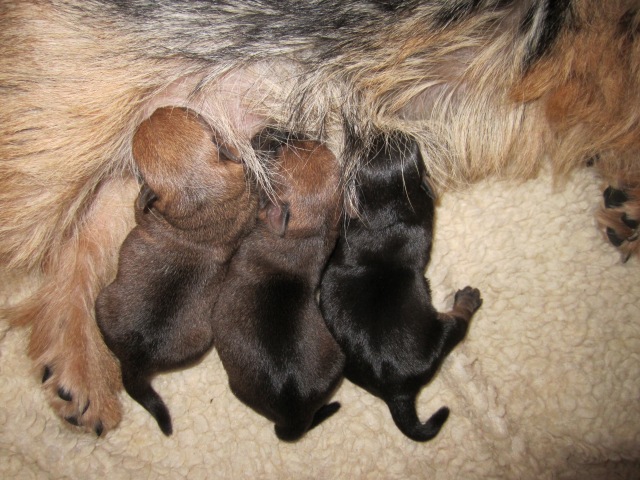

 Earlier this year a bitch I bred sold to another breeder had a Cesarean delivery and was not accepting the puppies. I told my friend about this study of the role of placentas and amniotic fluid in mother-puppy bonding, but alas there were no placentas saved. So I asked to please rub the puppies in any discharge from the mother. It worked! If you find yourself in a similar situation, remember about the role of the afterbirth in puppy acceptance and bonding.
Earlier this year a bitch I bred sold to another breeder had a Cesarean delivery and was not accepting the puppies. I told my friend about this study of the role of placentas and amniotic fluid in mother-puppy bonding, but alas there were no placentas saved. So I asked to please rub the puppies in any discharge from the mother. It worked! If you find yourself in a similar situation, remember about the role of the afterbirth in puppy acceptance and bonding.
 “Manding” is a term used in
“Manding” is a term used in 
 What Are the Chances Your Dog Has A Dental Problem?
What Are the Chances Your Dog Has A Dental Problem? When the periodontal disease is in its early stages, you might not even notice any symptoms. The dog might have occasional “bad breath”, an early sign of a periodontal disease, or not be as enthusiastic about his chew toys. Terriers are especially stoic and can live with considerable pain without giving you clues representative of the degree of their discomfort.
When the periodontal disease is in its early stages, you might not even notice any symptoms. The dog might have occasional “bad breath”, an early sign of a periodontal disease, or not be as enthusiastic about his chew toys. Terriers are especially stoic and can live with considerable pain without giving you clues representative of the degree of their discomfort. They revealed a splintered tooth and bone loss under the gum line. Kate is now 13 years old and doing great on the combination of a low dose of antibiotics every other day and probiotics on the days without an antibiotic. The treatment seems to be keeping the gram-negative bacteria in check. Kate had all her incisors removed but her remaining teeth have never looked better. She is free of discomfort and still able to catch rodents!
They revealed a splintered tooth and bone loss under the gum line. Kate is now 13 years old and doing great on the combination of a low dose of antibiotics every other day and probiotics on the days without an antibiotic. The treatment seems to be keeping the gram-negative bacteria in check. Kate had all her incisors removed but her remaining teeth have never looked better. She is free of discomfort and still able to catch rodents!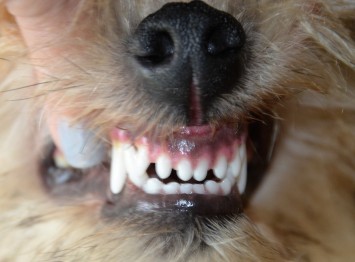
 Chromium-6 in My Drinking Water
Chromium-6 in My Drinking Water

 In my tap water there have been 7 contaminants found above the safe levels. Six of them carcinogenic chemicals:
In my tap water there have been 7 contaminants found above the safe levels. Six of them carcinogenic chemicals:





 During stage 1 we might go for a couple of very brief walks in the back yard, on a leash because mama dog might decide at that moment to find herself a den under a tree root, and believe me she might not come out once she makes that decision. It is better for both of us to stick to my plan. We might move around a couple of rooms. We often take short naps, on a bed. I’m OK with that because I know the difference between stage 1 and stage 2 labor. I don’t need to worry about a nice comforter or knitted blankets.
During stage 1 we might go for a couple of very brief walks in the back yard, on a leash because mama dog might decide at that moment to find herself a den under a tree root, and believe me she might not come out once she makes that decision. It is better for both of us to stick to my plan. We might move around a couple of rooms. We often take short naps, on a bed. I’m OK with that because I know the difference between stage 1 and stage 2 labor. I don’t need to worry about a nice comforter or knitted blankets.





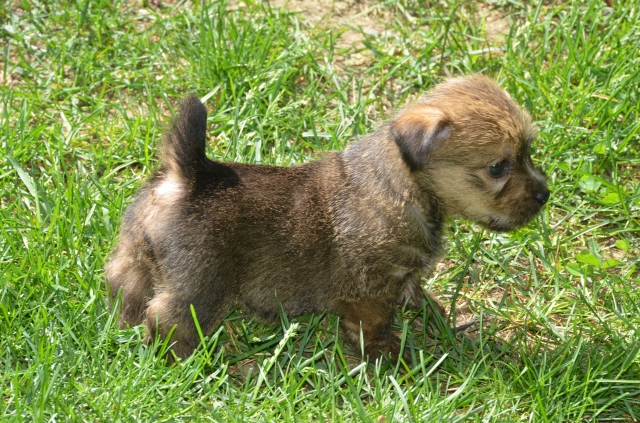

 I got an interesting question from a prospective puppy buyer. Do I use Early Scent Introduction (ESI) protocol with my litters? I never have but heard lots about it and am truly excited to experiment with it.
I got an interesting question from a prospective puppy buyer. Do I use Early Scent Introduction (ESI) protocol with my litters? I never have but heard lots about it and am truly excited to experiment with it.







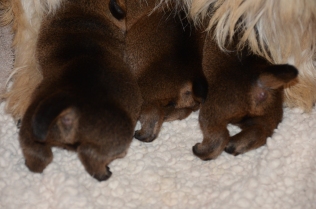

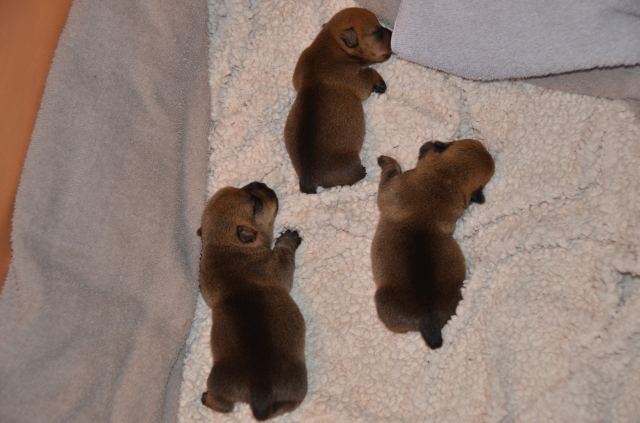




 also attending an obedience class and already skipped ahead a level. I always feel so pumped up with pride when I hear how easily Rolo learns, how enthusiastic he is to try new things.
also attending an obedience class and already skipped ahead a level. I always feel so pumped up with pride when I hear how easily Rolo learns, how enthusiastic he is to try new things.


 Derby has been learning some basic obedience, without a formal class yet, and we have started nosework. We took one outdoor nosework class together in the fall and trained at home in the winter. I also plan to show Derby in conformation in a little while.
Derby has been learning some basic obedience, without a formal class yet, and we have started nosework. We took one outdoor nosework class together in the fall and trained at home in the winter. I also plan to show Derby in conformation in a little while.